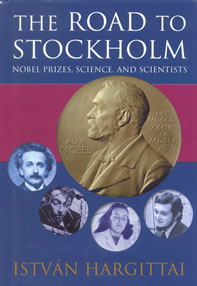|
|
Vol.
25 No. 1
January - February 2003
The Road to Stockholm:
Nobel Prizes, Science and Scientists
 István
Hargittai, (Oxford University Press, Oxford, 2002, ISBN 0-19-850912-X)
(xvii + 342 pp) István
Hargittai, (Oxford University Press, Oxford, 2002, ISBN 0-19-850912-X)
(xvii + 342 pp)
reviewed
by Joel F. Liebman
Athough István Hargittai
is an internationally recognized chemist, The Road to Stockholm
is not about chemistry or science per se, but rather about
scientists. It deals with the psychological and sociological
issues that have led to professional greatness and the greatest
institutional recognition a scientist can achieve (i.e., the
Nobel Prize). Among such issues are the following: upbringing
and the effects of deprivation and family strength; education
and the role of mentoring and academic pedigree; culture,
both national and religious; and competing demands, intellectual,
emotional, political, economic, and societal. The word "Road"
in the title is well taken. The book commences with a foreword
by Nobelist James D. Watson (co-awardee, Physiology or Medicine,
1962) that outlines some of his path— Hargittai amplifies
this at considerable length throughout the book. It is these
paths that fill much of this volume. There are many roads,
even if not so labeled as I so choose to label them here.
Quoting the poet, there’s "the road less traveled," the
special, unique, ignored observation, characterization, experiment,
or insight. There’s "the road to Damascus," the sudden
epiphany or "Aha!" and spontaneous, instantaneous change of
belief, action, or understanding. Recalling the comedian in
"the Road to Mandalay," the gentle, joyous excursion and adventure
that includes many serendipitous trips and seeming diversions.
There is "the road to Rome," one of many but gets the traveler
there fastest and first. Paraphrasing the cliché, "the
road from perdition," the survival from dysfunctional families
or from genocide. Asking the reader to pardon the reviewer’s
wordplay, there is "the Colossus of Rhodes," the sheer weight
and power of achievement and activity.
We often tell our students
that science, both idealized and practiced, is value free
and crosses all cultures, languages, and backgrounds. Not
so, Hargittai reminds us. National, religious, status, and
gender issues have all contributed to winning the Nobel Prize—and
not winning the prize. The final chapter is a poignant reminder
that only three people can win the Nobel Prize in a given
area in a given year, and so Hargittai discusses who did not
win but could/should have (in other words, who was "robbed,"
to quote a non-recipient). The chapter also contains some
prophecy on possible future recipients.
The book ends with four pages
of acknowledgements (nearly a page and a half therein to Nobelists),
45 pages of notes (footnotes and references), two pages of
citations to general reading, and 30 pages for the complete
list of Nobelists and the associated citations in physics,
chemistry, and physiology or medicine through 2001. Perhaps
to underscore that the subject matter is the Nobel Prize and
the scientists who won it—and some who didn’t—and
not the science itself, there is a 10-page name index, but
there is no subject matter index. There are also some 80 photographs:
two of the Nobel medal and the rest of the major persons who
populate the book.
It is the reviewer’s
feeling that Hargittai has written an interesting and important
book. The Road to Stockholm offers much insight and
information to the reader—at the least, we are given
a personalized view of scientists, their science, and the
world we share.
Joel
F. Liebman is professor of chemistry at the University of
Maryland in Baltimore.
www.roadtostockholm.com
Page
last modified 17 December 2002.
Copyright © 2002 International Union of Pure and Applied
Chemistry.
Questions regarding the website, please contact [email protected]
|